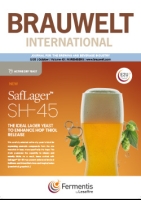On 1 July 2010 several staff changes occurred in the GEA Brewery Systems sales department, further enhancing efficiency.
In the hop garden portrayed on the left hand side (growing Perle), no re-training was carried out after the hail storm due to little time and a lack of man power and time. One can see quite clearly that only very few laterals have reached the top of the wire of
The official German 2010 hop crop estimates were published on August 26th. Following please find those estimates as well as the final world
The International Hop Standards Committee (IHSC), announces the release of a new calibration standard, ICE-3, for the HPLC analysis of α- and ß-acids. This standard replaces ICE-2, which is now withdrawn.
BrewingScience - Monatsschrift für Brauwissenschaft, 63 (May/June 2010), pp. 92-93
Multi-lane bottle conveyors are in use at almost all bottling plants. They are not only needed for the transportation of bottles but also for decoupling the failure sensitive machines of the plant by storing and providing bottles. This increases the overall efficiency of a plant by bridging short downtimes. These buffer conveying systems have to be controlled with regard to their filling level. State of the art is the stepwise detection of the filling level by mechanical switches, which are actuated by accumulating bottles. This leads to a stepwise control.
Combined particle analysis was applied as a tool to predict gushing in alcohol-free beverage products. Gushing is known as spontaneous overfoaming of carbonated beverages that is an intermittent problem for brewers and the beverage industry. Therefore, preventive tests to examine raw materials for their gushing risk are of interest for the industry. Previously, the focus of gushing tests was on the overfoaming of carbonated samples in specifically shaken bottles, after which the amount of overfoaming was recorded as the measure of gushing. As these tests require a number of days to be performed, it often happens that the raw materials have already been processed before the results are available. Here the combined particle analysis is presented as a “real time” alternative to such tests..
Particle analysis and its potential in describing the physico-chemical characteristics of particles in beer were investigated. It was the aim to figure out the feasibility for its application in brewing and beverage science. To describe existing problems in the beverage industry caused by insufficient physico-chemical stability of the beverages a rule of great generality according to the particle characteristics was also defined as follows: Beverages are liquids, in which colloids, also called particles, exist in disperged (e.g. beer) or emulsified (e.g. milk) form. One main particle characteristic is the surface. This can be seen in many interfacial phenomena, like the surface potential. Mathematically it was shown, that especially for small particles the ratio between surface and volume increases. Surfaces carry electric charges, which terminate or change the physico-chemical characteristics of the particles. By combining (1) the particle charge detection with polyelectrolyte titration for determining the surface charge, the surface potential and charge density of particles with (2) the particle size analysis by dynamic stray light to analyze the particle size and particle size distribution, the particles could be characterized.
Mid-year acreage estimates for all major hop growing countries have been published. After the 13.4% acreage increase from 2007 to 2008 there has now been a decrease of at least 11.6% for crop 2010. The largest decreases have occurred in USA and China, and the decrease in the PRC could in fact be larger than published. Overall the decrease takes worldwide hop acreage back to its 2007 level, which at the time did not supply enough alpha to meet demand. In the meantime variables have changed so short-term supply should be adequate. ...
Once every two years we publish the results of our world beer analyses. For this study, worldwide brands with a yearly production of at least 1 Million hl were selected. These brands represent approx. 43% of the total beer production in 2009, about 720 Million hl beer respectively.
As you know, the shortfall of alpha acid for the brewing industry from crops 2005, 2006 and 2007 resulted in acreage increases for crop 2008.
Primary beer gushing is defined as the wild and uncontrolled overfoaming of packaged beer induced by contaminated raw materials as barley and malt. It is generally admitted that most probably amphipathic molecules such as hydrophobins and non-specific lipid transfer proteins (ns-LTPs) are responsible for this phenomenon. These molecules are synthesized by moulds and by vegetal tissues respectively in order to modify the polarity of surfaces and the solubility of molecules. At present, hydrophobins are extensively studied as they are considered as the major responsible molecules involved in primary gushing. This review compiles the relevant fundamental physical and chemical properties of CO2 and experimental observations at laboratory and pilot scale.0 till 4.0 ATU of CO2 )..


